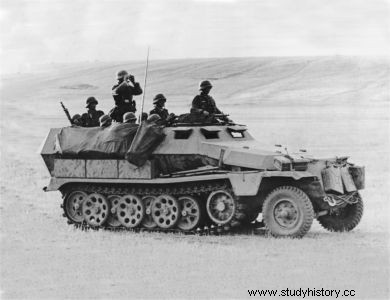
Mittlerer Schützenpanzerwagen, or SdKfz 251 , and many variations
Type:Troop Carrier.
Crew:2 men 10 fighters.’
Armament:A variety of weapons.
Shielding:minimum 7 mm:maximum 12 mm.
Dimensions:length. 5.8m;
width:2.10m:
height:1.75 m.
Weight:9.25 t
Engine:Maybach HL 42 TKRM 6 cyl, water-cooled petrol in-line, developing 100 hp at 2,800 rpm.
Performance:road speed 55 km/h;
autonomy. 320 km;
vertical obstacle. 0.30m;
straight cut 2 m:slope:24%.
Time in service:in the German army from 1939 to 1945.
The SdKtz 251 'was a semi-tracked armored vehicle used by the German army during the Second World War in the most diverse roles . This "jack of all trades" has
served as an APC, as a firing platform for (artillery (general or anti-tank), as a rocket-launching vehicle, a flame-thrower vehicle, a bridge-laying machine engineering, chemical warfare vehicle, etc.
The Hanomag firm undertook the initial studies in 1934. Commissioned by the Wehrmacht to build a 3 t half-track. The end result was the Hanomag HL KL 6, an unarmored half-track tractor. standardized under the designation SdKtz IL The high command requested the production of an armored version and the same firm developed the HL KL 6P, standardized under the designation SdKti 251. The machine entered service just in time to take part in the invasion of Poland in 1939, thus engaging in a relentless fight in all theaters of operations at the same time.
The base vehicle, the APC designated SdKfz 251/1, could carry ten infantrymen in addition to the driver and the captain. The total number of variants exceeded twenty and they were all distinguished by a slash followed by a number attached to the designation SdKfz 251. To be completely exact, the SdKfz 251 would have to be called “three-quarter tracked vehicle”. since the length of the track exceeded three quarters of the total length The undercarriage featured the quintessential (Famo) configuration of the road wheels. later used for the Panther medium tank.
To increase the free space inside the vehicle as much as possible. the body adopted hexagonal section specific to armored cars and the engine was placed at the front; which allowed the installation of gates at the rear To offer the driver an optimal field of vision, the bonnet had to tilt forward in a very pronounced way; for this reason, the steering wheel was located and almost horizontal position. The method of driving represented an innovation on this vehicle as well as on all the German half-tracks of the time For movement on the road, in circumstances. normal. the steering wheel only drove the front wheels (up to the angle of about 150) but, in off-road, where one obviously has to deviate more often from the straight line and the flat surface, the Cletrac system took over. The sa. The defect of this type of machine was its excessive cost price compared to that of full tracked or non-tracked ones.
